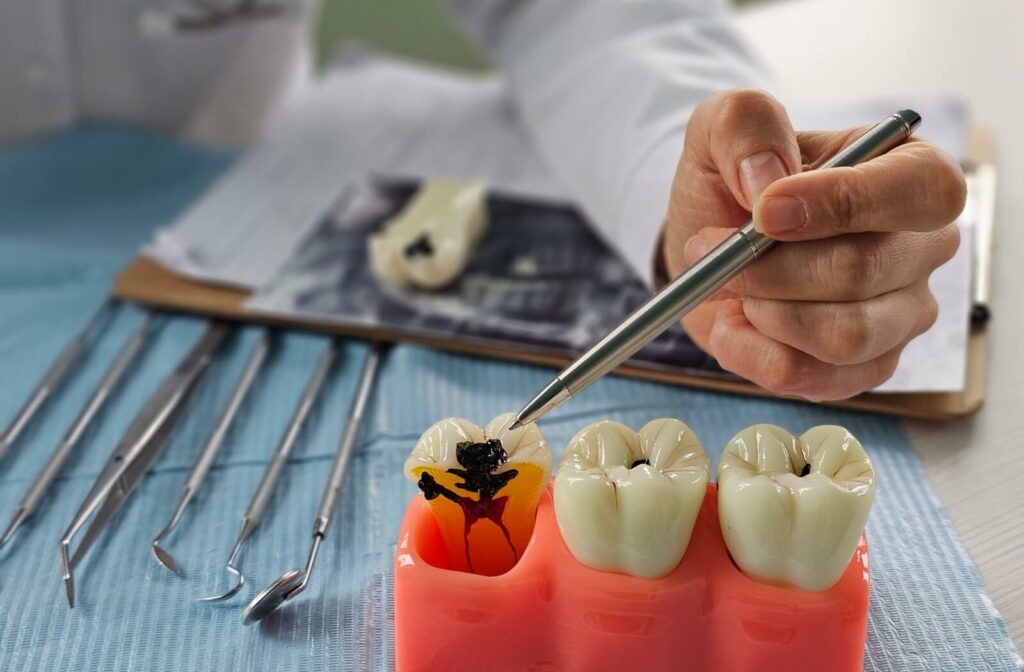A trip to the dentist sometimes includes filling a cavity (or several). It’s common for young children to be slightly hesitant when coming in for a cavity treatment, so becoming familiar with the process can relieve some of the anxiety that comes with it.
The time length for a cavity filling depends on factors such as the size and location of the cavity, the type of filling material used, and the patient’s age.
On average, the process can take about 20 minutes to an hour.
Routine dental cleanings and exams can help detect concerns, such as cavities, early. Timely intervention with a quick and simple filling can save you time, money, and discomfort down the road.
What Is a Cavity?
A cavity is a dreaded dental diagnosis for many parents and children, but what exactly is it? Here’s what you need to know.
A cavity (also known as dental caries or tooth decay) occurs when bacteria damage the tooth’s hard surface. This happens when leftover food particles, especially those high in sugar or starch, accumulate on the teeth and erode the enamel, creating small holes or hollow areas. This is precisely why daily brushing and flossing are healthy habits we strongly encourage!
A cavity will not heal on its own and requires a minor procedure, known as a filling.
Leaving a cavity untreated is never a good idea because it can grow larger and penetrate deeper into the tooth, increasing the risk of painful infections, tooth loss, or further complications.
Early detection fosters timely intervention, preventing otherwise manageable issues from snowballing into serious concerns. Besides, this can save your child from spending more time in the exam chair, as you save money on more complex procedures.
Your Guide to Cavity Fillings
A standard procedure to treat a single, small-to-medium-sized cavity generally takes 30 to 60 minutes. Larger cavities or multiple fillings during the same visit could take longer.
Knowing what the procedure entails provides a better understanding of the timing. Here’s a quick overview of the process:
Examination & Preparation
The dentist first examines the tooth and may take X-rays to confirm the size and location of the cavity.
After, the dentist numbs the surrounding area with a local anesthetic. This step alone usually takes about 5 to 10 minutes, depending on how efficiently the area numbs.
Removing the Decay
The next step is to carefully remove any decay from the tooth using either a dental laser or drill.
The time spent here depends on the cavity’s severity. Smaller cavities might take only a few minutes, whereas removing the decay from a larger area can take up to 15 minutes.

Filling the Cavity
Once the dentist addresses the decay, they’ll clean the area and apply a filling.
When it comes to the filling material, you have several options, including composite resin, amalgam, or glass ionomer, each of which influences the time it takes to place and cure the filling.
Composite resin fillings, for instance, require a curing light, and this process can take around 10 to 20 minutes.
Final Adjustments
After applying the filling, the dentist checks the bite to verify the filling fits comfortably while chewing. They can always make minor adjustments during this time if necessary. We want these fillings to last, and this requires precision, time, and care.
This final step is typically quick, lasting just a few minutes.
What Influences the Length of a Cavity Filling?
Now that you have a better sense of what happens during a cavity filling, we can go over the variables that affect the length of time this procedure takes.
The factors that influence how long a cavity filling takes include:
- The size and depth: Deeper or larger cavities take more time to clean than smaller, superficial ones.
- Location: Cavities on molars (back teeth) may take longer to treat than those on front teeth, which are more accessible.
- The filling material: Some materials, such as composite resin, require more time for curing and shaping than amalgam fillings.
- The patient’s age: Every child’s comfort at the dentist varies, and that’s okay! This treatment may take slightly longer with our younger patients, as extra care, comfort, and cooperation are required.
- Sensitivity or anxiety: Some people experience dental anxiety. Our team is happy to take extra steps to help your child feel calmer and comfortable, but this can add to the procedure’s total time.
Although the visit can take up to an hour, we suggest booking the appointment at a time that allows for some flexibility in case the procedure takes longer than expected.
When Does the Numbing Wear Off?
Solea Laser offers a drill and needle-free alternative to filling a cavity, eliminating the need for numbing agents altogether.
However, if we follow a more traditional filling process, we use a numbing agent to help minimize any discomfort during the procedure. The numbing agent’s effects can last from 1 to 3 hours, depending on the dosage and a person’s metabolism.
Since the mouth can feel very numb, we recommend monitoring your child after the procedure to make sure they don’t accidentally bite their tongue or scratch their cheek! We recommend having a light meal beforehand instead.
Experience Comfortable Care
A cavity is an uncomfortable experience for anyone, especially children. A gentle and thorough approach in the dental chair can help alleviate any worry or hesitation before filling a cavity, but it’s a procedure that’s best not to delay.
Instilling healthy oral habits at a young age, like routine brushing and flossing, and staying on top of your child’s dental visits, encourages healthier outcomes for years to come.
Connect with our Bloom Orthodontics team to schedule an appointment for your child’s cavity filling!



